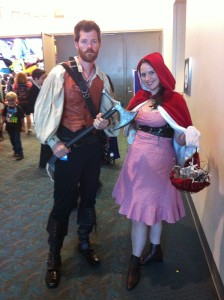I just got back from San Diego Comic-Con!! Here I am with my husband, rocking our fairy tale costumes:
We’re already contemplating what we might be next year. I suggested Sailor Moon and Tuxedo Mask (adolescent dream come true!), and he said he’d consider it… if we could zombify them. Ha! I guess we’ll see.
Anyway, on to today’s blog post!
Solo Presentations for Authors: A Breakdown
Last week I talked about the what, how, and why of author panels. Today I’m offering tips for an even more intimidating type of presentation: when you have to go it alone.
When Cinder came out, I was more-or-less thrown into the deep end as far as author presentations go. The day of Cinder’s release I had my launch party in Tacoma, WA. The next evening I was at Joseph-Beth Booksellers in Cincinnatti giving my first solo presentation as a published author.
Since then, I’ve honed my talk/presentation into something that I hope is fun and entertaining for readers who come out to the events. But I’ve been to enough author signings as a fan/reader myself that I’ve started to notice a lot of authors seem lost in front of an audience, and I’ve met plenty of authors who are terrified by the idea of presenting solo.
But if you’re writing in a genre where publishers frequently tour their authors, the reality of touring may very well be in your future.
So here are some general tips and tricks I’ve picked up both from giving and watching solo presentations.
– Tell anecdotes. Readers usually want to know where the idea for a story came from, so that’s a good place to start for just about any writer. Beyond that, give some thought to the writing process and if there are any interesting or humorous experiences that went along with it. Did you learn some fascinating tidbits while conducting research? Did you travel anywhere cool? Did a completely bizarre run-in with a stranger inspire one of your quirkiest characters? Readers love this behind-the-scenes info.
(During my presentations, I usually talk about getting my start writing Sailor Moon fanfiction, the short story contest that inspired the Lunar Chronicles, and the NaNoWriMo contest in which I wrote 150,000 words in an attempt to win a walk-on role on Star Trek. I didn’t win either contest, but it still makes for a decent story.)
– Show and Tell. Props can be a great way to break the ice with an audience – it gets their eyes off of you for a little while, and it gives you something to do with your hands. What can you bring to show your readers? Copyedited pages and page proofs? Foreign editions with unique cover art? Inspiration photos? Many readers are interested in the publishing process, so props can also help segue into a talk about what happens between selling a book and it hitting bookshelves.
– To Read or Not to Read. Some writers are very, very good at reading their own work. If that’s you – by all means, go for it! I recommend choosing a short passage that has some humor in it. Like, two pages or fewer short. Unless you’re going to do character voices or act it out with sock puppets or entertain in some other way, people get bored really fast listening to a person read. (Plus, there’s a good chance that many people in the audience will have already read your book!) So keep it short and sweet. Also, practice looking up once in awhile to make eye contact with the audience. It’ll feel weird at first, but will keep them engaged more than if you’re hiding behind the book the whole time.
That said, if you’re like me and you HATE reading your own work (with a great, burning passion), it’s almost always acceptable to skip it. Most bookstores don’t care, as long as you’re presenting in some other way, as discussed above. Or, what about reading something that’s NOT your own book? Crazy, I know, but I’ve started telling some of the old Grimm tales at my events. Not reading word-for-word, but my own summarized versions of them. It’s fun and so much more enjoyable, for both me and the audience.
– Q&A. I suggest leaving at least 10 to 15 minutes for Q&A. For me, this is the easiest part of the presentation – I could answer questions all day long. It tends to be pretty laid back, and if readers are asking questions, then you know they’re engaged with what you’re saying.
That said, it can be tough to get the questions going, especially if you’re presenting to a smaller audience. People are shy and no one ever wants to go first! For this, I started bringing prizes for the first three people to ask questions. It doesn’t have to be elaborate – a signed bookmark will do. But everyone loves free stuff and once you get those first few questions out of the way, it tends to loosen everyone up.
– Presentation length. I try to aim for about 45 minutes of speaking time at my events. I feel that’s long enough that people who drove a long ways will feel it was worth their time, but short enough that people don’t start getting antsy, and it leaves plenty of time to sign books. My solo presentations look something like:
– 15 minutes: The story of where I got the idea, writing the book, getting published
– 10 minutes: Tell some Grimm fairy tales
– 20-25 minutes: Q&A
– Sign books!
I hope that gives you some ideas for what to do when it comes time to give solo events. I know they’re intimidating, but they can also be a whole lot of fun, and readers will appreciate you putting some thought into your speech rather than just giving a 30-minute reading of your work. Trust me.
Questions/thoughts? Let me know in the comments!
